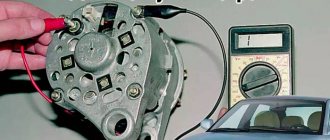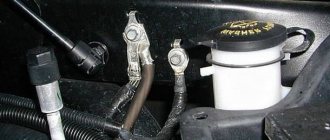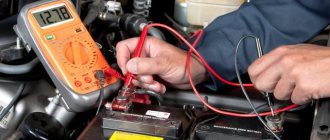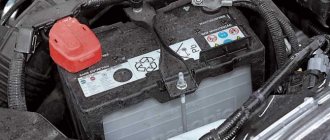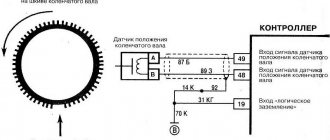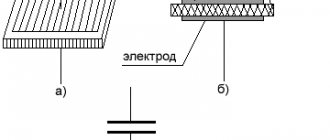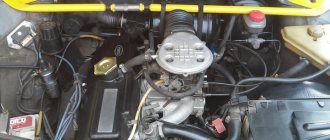The battery is an important component, without which the car simply will not run. Many drivers treat the battery as a consumable item - they replace it with a new one when it starts to act up. Power supplies “age”, but this can be slowed down if they are serviced on time and operating rules are followed. Testing the battery with a multimeter will allow you to evaluate its performance.
Checking the battery with a multimeter is necessary in order to notice possible malfunctions in time.
How to check the battery
When learning how to measure battery capacity with a multimeter, you need to consider the procedure for a vehicle battery.
A full check of the autonomous power source will allow you to avoid problems in the vehicle’s electrical network and extend the life of the battery. First, the battery must be disconnected from the machine system. It is allowed to disconnect only the “minus” contact. Next you need to turn on the multimeter. The test mode is set to the range from 0 to 20 V.
The multimeter probes are connected to the battery contacts. A red wire is connected to the positive terminal, and a black wire is connected to the negative terminal. If this procedure is performed correctly, the measurement result will appear on the device screen.
Measurements while the engine is running
Place the car on a level surface, open the hood, put the handbrake on and start it. When the engine is running, the generator and voltage regulator operate, which charge the battery. Therefore, the voltage at the terminals should be within 13.5-14 volts. In some cars, when the battery is discharged and the air temperature is low, the electronics automatically increases the voltage to speed up charging. In this case, it should fall smoothly as it charges. If this does not happen, the electrolysis process is activated in the banks. The electrolyte will begin to boil away rapidly. Overcharging is especially dangerous for modern gel batteries with limited gas emissions.
A voltage of less than 13.4 volts is a sign of undercharging. Operating in such conditions promotes sulfation of the plates and shortens battery life.
When measuring voltage, you need to turn off all powerful consumers: headlights, heater, audio system. Otherwise, the power of the generator when idling will not be enough to maintain the optimal voltage level.
There are several possible reasons for low voltage at the terminals:
- Poor contact.
- Generator failure.
- Voltage regulator malfunction.
You cannot operate a machine whose battery is in undercharge mode. The cause of the failure must be immediately localized and eliminated. If the voltage at the terminals and the output of the generator is very different, you need to clean the contacts on the battery with sandpaper or a file.
After checking without load, you need to turn on the headlights and other powerful energy consumers, add engine speed and repeat the measurements. If at high speeds under load the voltage drops to 13.4 volts or lower, diagnostics of the generator system and control unit is required.
How to test a battery with a multimeter with the engine turned off?
The average indicator, when checking the battery with a multimeter, with the engine not running, should be in the range of 12.5–13 V, with the upper value indicating 100% charge, and the lower value indicating 50%. The numbers are approximate, but the general picture is easy to understand. Also, do not forget that you should take readings immediately before the trip, and not after it, as soon as you have turned off the engine. It is especially good to carry it out when the car has not been used for some time, for example, in the morning after a night in the garage. This shows how well the battery can hold a charge.
Now you understand how to check the charge of a car battery with a multimeter. This device is worth purchasing for every motorist. Some rely on the on-board computer, but it does not provide sufficient accuracy. The built-in voltmeter is connected to the circuit of devices that consume energy, and not directly to the battery, therefore, part of the electricity is consumed “on the road”.
How to measure battery leakage current with a multimeter
Any battery has leakage current. It is important to ensure that the value does not exceed approximately 80 mA. The fact is that energy, at least a little, is consumed even with all consumer parts of the car turned off. It is also worth considering that energy supports the functioning of the alarm system.
If the leak is too large, then diagnostics are required.
How to measure a battery with a multimeter for current leakage:
- Turn off the engine.
- Turn off the ignition.
- Wait 15 minutes.
- Turn off absolutely all consumers.
- Remove the negative from the battery.
- Set the multimeter to DC current test mode.
- Select range up to 10 A.
- Connect the positive cable of the multimeter to the positive cable of the battery.
- Connect the negative battery to the removed negative terminal.
- Record the indicators.
If there is no leak, you will see zeros. If there is a leak, you will understand from the values how big it is. You can find out where the problem lies: you need to turn off and turn on the fuses one by one.
It’s so easy to figure out how to measure a battery with a multimeter on a car for current leakage.
Now you know how to measure amperes on a battery with a multimeter, how to check battery charging with a multimeter, how to test a battery with a load with a multimeter, and much more. And for such testing you will need a regular multimeter, and you do not need a load fork.
We wish you to measure the battery with a multimeter correctly and safely!
How to Visually Check a Car Battery Case and Cables
Now it's time to check the physical condition of your battery. A damaged battery case can not only prevent the battery from working properly, but can ultimately kill it. To check it, you need to remove it from your car.
Disconnect the cables first, starting with the ground terminal and then the positive terminal. Now unscrew the clamping mechanism to remove the battery from the tray. Make sure the holding mechanism works. If it doesn't exist, install it. This equipment prevents the battery from rebounding and becoming damaged while the vehicle is in motion.
Place it on a work surface or similar surface. Carefully inspect the battery case for possible damage. Check for a bulging side or cover, cracks around the housing, or damaged terminals. If your battery is damaged, replace it. Overcharging and internal short circuit will cause the battery to swell as the acid turns to gas. So if you notice signs of a bulge, check the charging system as well.
Now check the cables. Check the insulation around the cables and the condition of the cable threads for wear, cracks or fraying. Replace them if necessary. Make sure the clamp mechanism on your battery is working.
How to check the battery
Procedure for removing the battery from the car.
Before starting tests, you need to visually assess the condition of the power source. For example, a damaged housing can cause its failure.
For a better assessment, it is better to remove the battery from the socket. Disconnect the cables in the following sequence: first the ground terminal, that is, “minus”, then “plus”. To remove the battery, just unscrew the clamping mechanism. There is also a holding mechanism and this should be in working order as it prevents the battery from shaking.
The serviceability or malfunction of the battery can be determined by external signs. If bulges are visible on the side or on the cover, cracks, or damage to the terminals, the power supply has probably become obsolete. If it's just the cables, they're worn out or cracked, replacing them is much easier.
What parameters can be checked?
Using a multimeter, you can measure voltage with high accuracy. By the magnitude of the electrical voltage, you can determine whether the battery is charged or the element needs to be charged with direct current.
Using a multimeter, you can check the voltage not only of acid batteries, but also of cell phone batteries. To check the mobile phone's battery charge level, the device is switched to the mode for measuring direct current up to 20 V. In this mode, the digital device allows you to measure voltage with an accuracy of hundredths of a volt.
The screwdriver battery can also be easily checked with a multimeter. The rated voltage of the device, in this case, can be found out from the documentation of the power tool, and if the voltage is less than this value, then the battery must be charged.
The battery capacity can also be checked with a multimeter. For this purpose, you can use several methods.
You can check current leakage using a multimeter. If it is necessary to measure this parameter on a car, then in addition to the current leakage on the body, the leakage in the vehicle’s on-board network is also checked.
In this way, you can prevent rapid discharge of the battery and increase its service life.
How to check battery charge with a multimeter?
Determining the condition of a lithium-ion (the most common type of modern battery) battery is quite simple if you follow these instructions:
- Disconnect the energy storage device from the car and wait 5-6 hours.
- The multimeter should operate in the “voltage” mode (voltage test).
- A standard lithium battery produces current in the range of 12.7–13.2 volts. The switch is set to 20 or closest to it. This is how the voltage is measured from this value and below.
- The wires coming from the device are connected to the battery: red to the positive terminal, black to the negative terminal. If the wires are the same color, then you should focus on their markings and connect them to opposite charges, minus to plus and vice versa.
What is a multimeter and how does it work
A multimeter is a device that can be used to measure battery voltage at home. And based on the voltage value, it is easy to determine whether it is charged or needs recharging.
Typically, the device measures voltage, but it can also be used to find out:
- about the fact of current leakage;
- energy intensity;
- internal resistance;
- current or amperage.
By the way, the need to measure voltage sometimes arises not only if you have a car battery, but also a power source for a smartphone or any other device.
Of course, batteries are sold with an indicator that shows the charge. But such models cost 20–30% more than regular ones. By acquiring a multimeter and learning how to use it, you can really extend the life of your battery.
Using a hydrometer to check battery fluid
- Remove the caps from the top of the battery.
- Immerse the tip of the hydrometer into the first cell of the battery and squeeze out the hydrometer bulb.
- Release the bulb so that the electrolyte enters the hydrometer needle.
- Read the specific gravity of the electrolyte as indicated in the instructions on the tool packaging.
- Record your values and perform the same test on the remaining cells.
- Compare your results with the results of the tool manufacturer's instructions.
Basically, if your readings fall between 1.265 and 1.299, your battery is charged. When your readings drop below 1.265, your battery will not be sufficiently charged. In most cases, a slow or fast charge will help restore charge and improve the chemistry in the battery. However, a difference between 25 and 50 points or more (the point is 0.001) between any of your readings indicates that the battery is sulfated and you need to replace it.
How to check the battery charge using the indicator
Many maintenance-free batteries have charge indicators that allow you to visually determine the condition of the battery. This option first appeared on Japanese products and quickly gained popularity due to its convenience and accessibility.
The hydrometer, as the indicator is called, is a transparent window on the battery cover. The color of the window changes depending on the condition of the battery:
- Green —full charge.
- Gray or white - need to be charged.
For some indicators, the window turns red when capacity is lost.
The principle of operation of the device is based on changes in the density of the electrolyte at different charge levels. It works like this:
A tube with a green float is attached to the window.
- When charging the battery, the density of the electrolyte increases and the float rises, approaching the window.
- If the battery is discharged, the density drops and the ball sinks in the electrolyte. As a result, the indicator window changes color to gray or black.
Some indicator models have a red ball that floats up when the density of the electrolyte decreases. This provides a red indication of the discharge.
When the electrolyte level drops, not the ball, but the electrolyte itself will be visible through the window. To prevent the destruction of the plates, you need to add distilled water to the jars and charge the battery.
The advantage of the indicator is that the device allows you to determine the condition of the battery without the use of special instruments. This is convenient when purchasing a battery or in road conditions when you need to quickly check the condition of the battery. However, indication using a float does not always allow one to draw accurate conclusions about the performance of the battery. Therefore, when in doubt, you should use a multimeter or a load fork. They are also useful when you need to check a battery that is not equipped with an indicator.
Conditions under which battery performance is tested
Before checking a car battery with a multimeter (in order to determine what condition it is in), you will need to carry out preparatory operations. To do this, you must first disconnect the battery terminals and let it stand for about 5-6 hours. Then you need to prepare a complete set of tools used for testing. It includes:
- The multimeter itself with test leads.
- Load fork.
- Halogen lamps (2 pieces).
Upon completion of the preparatory operations, begin the measurements provided for by the battery test program with a multimeter. Depending on the readings obtained, a decision is made on the need for replacement or continued operation of this sample.
How to Test Battery Terminals Using a Multimeter
Dirty, corroded or loose terminals will lead to starting or no-starting problems and are one of the main reasons people think they have a "dead battery". Sometimes such problems are difficult to detect with a simple visual inspection.
Here you will use a voltmeter (or multimeter set to voltage) to check the battery terminals for voltage drop so you can understand the status of your battery connections.
First turn off the ignition system. Do this by temporarily disconnecting the ignition coil or removing the fuse, or the fuel pump relay (if necessary, find your vehicle's owner's manual or your vehicle's repair manual to locate the coil or fuse). This will prevent your engine from starting.
Use the red positive wire to touch the positive terminal of the battery and hold. Touch the black wire (negative) of your meter to the terminal of the negative wire that goes onto the battery. Have a helper crank the engine. If your meter registers more than 0.5 volts, you will need to clean or check the physical condition of the terminal and terminals.
Now check the other battery terminal. This time, however, use the black probe of your meter to touch the negative terminal of the battery. Now touch the red probe of your meter to the cable terminal connecting to the same battery terminal. Have your helper start the engine and check the voltage reading on your meter. If it exceeds 0.5 volts, you need to check the battery terminal for damage or clean it.
Check internal resistance
To check the battery for serviceability using a multimeter, you need to measure the internal resistance of the battery. You can check the functionality of the power source using a multimeter and a powerful 12 V light bulb. You need to check the battery in the following sequence:
The 12 V lamp is connected to the battery.- After a few seconds of the lamp glowing, the voltage at the battery terminals is measured.
- The lamp turns off and the voltage is measured again.
If the measurement difference does not exceed 0.05 V, then the battery is in good condition.
In the case where the voltage drop is greater, the internal resistance of the power source will be higher, which indirectly will indicate a significant deterioration in the technical condition of the battery.
In this way, it is possible to fairly accurately check the power source for serviceability.
How to check the “amperage” of a battery with a multimeter?
To determine the current that your battery produces, you will need to create a circuit with a load. Its role is played by any device or equipment that consumes electricity. To take measurements you will need to take the following steps:
- The device is set to ampere measurement mode, and the switch on it is set to alternating current, which is designated by the English letters AC.
- Disconnect the positive terminal of the battery and replace it with the negative wire of the measuring device.
- To the equipment that acts as a load, connect the negative terminal of the battery and the meter probe with a positive charge.
- Depending on the design, look at the displayed number or count it on the instrument scale.
A serviceable and fully charged battery exhibits readings in the range of 12.6–13 V.
How to measure voltage
If it is necessary to check only the battery voltage, then the multimeter is switched to DC mode. If you need to check a source of electricity whose voltage does not exceed 20 volts, then in this sector the mode switch is set to the 20 V position.
Then the black probe of the multimeter should be connected to the negative terminal, and the red one to the positive terminal of the battery; the device display, at this moment, will show the DC voltage.
Typically, a serviceable and fully charged car battery has a voltage of 12.7 V. If at this voltage the electrolyte density is normal, then the source of electricity can be used for its intended purpose.
The voltage of lithium-ion batteries of cell phones, as well as alkaline or gel batteries, which are used to start the engines of various motorcycles, diesel generators and other devices that require a certain charge of electricity to start operating, is measured in a similar way.
How to test a battery with a load fork?
This is the most accurate method to determine the state of charge and the ability of the battery to operate at full load. It is used by professional auto electricians in service centers.
A load fork is a device that combines a voltmeter and a load resistance. Advanced versions of the device are also equipped with an ammeter, which allows you to estimate the load current. The fork operates in two modes:
- battery voltage measurement;
- imitation of starter operation.
Before starting the test, you should turn on the voltmeter mode on the load plug and connect it to the battery. If the device shows less than 12.7 volts, the battery needs to be charged.
| Voltmeter readings under load | >10.2 V | 9.6 V | 9.0 V | 8.4 V | <7.8 V |
| Charge percentage | 100% | 75% | 50% | 25% | 0% |
Table of battery charge level depending on electrolyte density
| Charge level (%) | Electrolyte density (g/cm³) | Degree of discharge (%) | Battery voltage (V) | Charge time at 10% capacity (hours) |
| 100 | 1,277 | 0 | 12,73 | Not necessary |
| 90 | 1,258 | 10 | 12,62 | 2 |
| 80 | 1,238 | 20 | 12,50 | 4 |
| 70 | 1,217 | 30 | 12,37 | 6 |
| 60 | 1,195 | 40 | 12,24 | 8 |
| 50 | 1,172 | 50 | 12,10 | 10 |
| 40 | 1,148 | 60 | 11,96 | 13 |
| 30 | 1,124 | 70 | 11,81 | 16 |
| 20 | 1,098 | 80 | 11,66 | 20 |
| 10 | 1,073 | 90 | 11,51 | 24 |
| 0 | 1,06 | 100 | 11,4 | Sulfation |
The degree of charge of a battery can be judged by the density of its electrolyte. The lower the density, the more the battery is discharged.
How to check battery capacity
We found out that checking the battery's state of charge with a measuring device is not only possible, but also not difficult at all. But is it possible to check the battery capacity with a multimeter? This question still needs to be sorted out. This can be done if, in addition to the measuring device, you use an artificial load and a clock (timer).
Additional information: The load function is performed by two halogen lamps, and a timer found in any phone is suitable for measuring time intervals.
The total power of the light bulbs will be equal to 110 Watts, and the current flowing through them will be about 8.5-9 Amperes.
To measure the battery capacity you will need to do the following in the sequence below:
- First you need to fully charge the battery being tested.
- Then you should connect a load and a multimeter to the terminals, the switch of which is switched to voltage measurement mode.
- When connecting them, you should note the time and wait until the voltage at the terminals drops to 10.3 Volts.
- Having determined by the clock the time this reading was taken, we calculate the interval during which the battery was completely discharged.
Let it be equal to 6.5 hours. Checking the capacity with this data is very simple: you need to multiply the resulting time in hours by the discharge current in amperes. The result is the battery's energy capacity in amp-hours. In our case, it has a value of 6.5x8.5 = 55 A/hour.
Please note: If the passport of the most tested battery shows the figure 60 A/h, then it is in satisfactory condition and you can continue to work with it.
During operation, you should always remember that car batteries do not tolerate deep discharge well. Therefore, it is necessary to constantly monitor the voltage at its terminals, which is directly related to the value of the capacitance. If a drop in this indicator is detected below 10.3 Volts, it will be necessary to carry out a control check of the energy intensity in the manner described above. Upon completion, it is imperative to restore the battery’s functionality with a carefully selected charging current.
Another way to determine battery capacity is to take measurements using a battery capacity tester.
Battery capacity tester
Voltage check
The voltage at the battery terminals is the main indicator of its performance and the possibility of further operation. Before measuring the voltage at its terminal contacts, you will need to perform the operations in the order listed below:
- First, the battery itself is prepared, for which its surfaces in the terminal area are thoroughly wiped with a rag.
- Then you need to switch the prepared multimeter to the appropriate mode (“voltage”) and proceed to measuring the parameter.
- Next, select the reading limit (for this case, “20 Volts” is suitable).
After this, the measuring probes of the device will be connected to the corresponding terminals of the battery (the wire in red insulation is to the plus, and the black wire is to the minus). In conclusion, the obtained readings should be compared with the standardized values.
Please note: When checking the battery voltage with a multimeter, the device should show a value in the range from 12.6 to 13.0 Volts.
With lower readings, the battery needs to be recharged, which requires a special charger (charger).
Criteria for evaluation
When assessing the current condition of the battery, it is necessary to proceed from the following criteria:
- battery voltage readings in the range of 12.6-13.0 Volts indicate that the battery is well charged and fully ready for use;
- values of 12.1-12.4 Volts are a sign that the battery is not fully charged and needs to be recharged;
- 11.6-12.0 Volts indicate a strong discharge of the battery, which is unsuitable for operation;
- readings less than 11.0 Volts mean that the device is completely discharged and requires special recovery procedures.
To resuscitate a completely dead battery, you will need to carry out a series of recovery operations described in the corresponding section.
How to check battery amperage
To determine how the battery amperage is checked with a multimeter, the user will need to create a special load circuit. Either halogen lamps or a special load plug can be used as a consumer.
To measure the battery current with a multimeter, you must do the following:
- Switch the multimeter to the “Amperes” mode at the limit of 10 A (20A).
- Connect the red test probe of the device to the positive terminal of the battery, and the second (black) to one of the 2 load contacts.
- Its second contact must be connected to the negative terminal of the battery.
Please note: As a result of these actions, a sequential closed circuit will be obtained, in which the current will flow through each element, including the measuring device.
Its display will display a reading corresponding to the load current value.
Checking internal resistance
Using a universal multimeter type device, you can check the battery for its internal resistance. To carry out such measurements, you will also need a special load (its function is usually performed by an ordinary 60-watt halogen light bulb with a current consumption of about 5 Amperes.
Additional Information. According to current standards, voltage loss across the internal resistance of the battery at 100 amperes of load current should not exceed 1 Volt (1%).
When recalculated for a current load of 5 Amps, the corresponding losses should not be more than 0.05 Volts.
To check the resistance of the plates in a battery with a multimeter, you will need to perform the following series of operations:
- First you need to connect a halogen lamp to the battery terminals and wait until it starts to glow.
- Immediately after this, you will need to measure the voltage at the terminals using a multimeter and record the resulting reading.
- Then you need to disconnect the lamp from the battery and again record the voltage value at its terminals.
At the final stage of the test, the difference between the two readings obtained (without load and with load) should be determined. If this value does not exceed 0.05 Volts, then the battery being tested has a sufficiently low resistance and does not reduce the operating voltage. Otherwise, you will have to accept that the battery is very worn out and needs to be replaced.
Reinstalling the battery
After cleaning the case, terminals and tray, reinstall the battery.
- Carefully place it on the tray.
- Attach to tray using clamping mechanism.
- Connect the terminals. This time, start with the positive terminal and connect the negative or ground terminal last.
- After connecting the terminals, spread a thin layer of Vaseline around the top of the terminals and terminal posts. This prevents corrosion from accumulating around the terminals.
Quick battery check
In some cases, car owners have absolutely no time to disconnect the battery from the car, as well as “digging” with the lighting and dashboard. Such car owners determine the battery charge level without removing it, right under the hood.
The process looks like this:
- When the car freezes after turning off the engine, the multimeter is connected to the battery according to the scheme: plus to “+”, minus to “minus”, respectively. It is worth considering that the indicators will have minor deviations. 12.7 Volts is a normal indicator.
- Then the car starts. When the motor starts, the voltage will rise to 14.7 Volts.
- It is recommended to check it under load (external lighting, window heating, medium heater mode). In this case, the norm is 14.6 Volts.
Measuring the voltage of a car battery with a multimeter is a feasible task even for a novice car enthusiast. Not everyone can afford an expensive battery equipped with a special indicator.
A practical and universal option is to measure the battery charge with a multimeter. This device, with a talking prefix “MULTI”, allows you to measure not only voltage, but also current. In addition, the multimeter can be useful for other electrical equipment, including phones, laptops, and screwdrivers. Remember that it is better to purchase such a device from trusted manufacturers in specialized stores.
How to measure current with a multimeter on a battery
This is a question like how to check the amperage of a battery with a multimeter. Load is definitely needed.
It is pointless and even dangerous to measure the current strength on the battery itself.
A headlight lamp can act as a load element. Remember that the load cannot be higher than 120 W.
How to measure battery current with a multimeter:
- Set the meter switch to measure the required current.
- Select the Ampere limit (maximum is better first).
- Connect the positive probe to the battery positive.
- Connect a lamp to the minus gap. That is, the minus from the multimeter should be directed to the lamp, from which the circuit is closed on the battery minus.
- Check the values on the multimeter. Compare them with those indicated on the battery case.
Make sure that the contact of the probe with the battery lasts no longer than two seconds!
We learned how to use a multimeter to test the amps of a car battery. The main thing is to do everything quickly and accurately. And you can do this because you know how to check the current strength on a battery with a multimeter.
The video explains in detail how to check the battery current with a multimeter:
How to clean a car battery
- Cleaning the battery case
You can use a simple procedure to clean the battery case. To do this, you need to prepare a mixture of 8 ounces of warm water and one tablespoon of baking soda. This neutralizes the acid and helps remove dirt from the battery case and terminals.
Wear safety glasses and rubber gloves and, using a soft brush, apply the solution to the top of the battery and the sides of the case. If your battery uses compartment caps (serviceable batteries), do not allow the mixture to seep under the caps and mix with the electrolyte inside.
Wipe with the solution and a clean rag. Continue applying the cleaning solution until you see no signs of buildup.
- Cleaning the Battery Terminals
As with the battery, remove dirt and corrosion from the terminals using baking soda and a water solution.
To make your task easier, pour the mixture into a Styrofoam or similar disposable cup and submerge the battery terminal in it for a minute or two. Next, use a battery compartment cleaning tool to finish removing corrosion from the terminals. Repeat the procedure until you see that both cables are free of corrosion.
- Cleaning the battery compartment
Check the condition of the battery compartment. Make sure there are no screws, cracks, pieces of dirt or signs of corrosion. If necessary, use the same solution to remove dirt and corrosion from the pan.
Checking current for leakage
In exactly the same way, you can measure current leakage in a car - with a current clamp or a multimeter. The measurement scheme will be the same as the previous one. Before starting the measurement, you must turn off the engine and disconnect obvious consumers:
- lighting equipment;
- car radio;
- other loads.
If the measured leakage current exceeds a reasonable value (the approximate sum of the remaining loads - car alarms, other car electronics that cannot or are difficult to turn off), you need to look for a problem - short circuit, insulation or contamination overlap, etc. You must understand that if a leak occurs through a contaminated battery case (oil stains, electrolyte, adhering conductive dust), then it will not be detected in this way - the current path will be directed past the circuit being measured. Therefore, at the first suspicion of abnormal consumption, you need to clean the battery case from dirt (for example, wash it with detergents).
Leakage current paths along a contaminated housing.
For more details, read the article: How to find current leakage in a car with a multimeter
How to make a device with your own hands
When the necessary equipment is not available, you can make the device yourself by watching the video. It is necessary to take a voltmeter from ready-made instruments, and the remaining parts are constructed from improvised means. Difficulties will arise when calculating and creating internal resistance, which requires current.
A suitable material is nichrome wire, used to create heating coils in electric stoves. Nichrome elements can be replaced with a metal strip from other heating devices.
For a voltage of 12 V, the current indicator should be within 80-120 Amperes, and the resistance should be 0.1-0.15 Ohms. A device for measuring such resistance is difficult to find. For this reason, the length of one element is selected and the current that it passes is measured. After this, several similar parts are combined.
A homemade device is made sequentially:
- Select a nichrome wire or heating strip and measure the current up to 15 A with a multimeter. The element should pass 10-12 A.
- 10 such parts are connected, receiving a load of 100-120 A. The wire must be twisted securely.
- The resulting element is placed in a suitable housing and fixed in it. If the box is small, then the wire is bent several times so that the turns do not touch each other. The parallel connection must be reliable, which is ensured by insulating cylinders that are installed on the bends.
- The ends of the twist are soldered to the output contacts, and from the outside to the connecting wires.
- Connect a voltmeter.
- Clamps are attached to the ends of the connecting cable, which are then connected to the battery.
When the device is ready, you can take measurements at home.
Methods for diagnosing a car battery
Let's consider the main methods for checking the technical condition of a car battery:
- Terminal voltage. A multimeter is a device for measuring current and voltage. Can be used at home.
- Diagnostics using a Postolovsky oscilloscope. USB Autoscope is a professional device for checking electrical signals in the engine and additional equipment, including the battery. For this purpose, Andrey Shulgin has developed a special ElPower script that can detect battery faults and charge level.
- Checking with a load fork. The most informative device for measuring voltage under load.
- Checking the electrolyte level. It should be 10-15 mm higher than the plates.
- Electrolyte density measurement. A hydrometer is used for this.
- Check battery capacity. On the case there is information about its capacity. The year of issue is written in the passport.
The average check price varies from 300 to 500 rubles, depending on the make of the car.
Battery diagnostics using a Postolovsky oscilloscope
Check the car battery charge with a multimeter
If the starter turns poorly or the car does not start, the first thing you need to do is check the battery charge. This service is available at a car service center, but to do this, the car will have to be transported on a tow truck. If you have a tester at hand, you can check it yourself at home.
A multimeter is a universal device. It is used to measure leakage current and battery voltage. We set the regulator knob to 20 Volts DC voltage and measure the health of the battery. Red probe for the positive terminal, black probe for the negative terminal. The readings should be from 12 volts when the car is not started and up to 14.7 volts while the engine is running. Depends on the brand of the car, and accordingly on the generator and the general layout of the installed equipment. The charge level is checked an hour after stopping the engine.
Checking the battery on a car using a load fork
The load fork is a unique device for measuring the charge, voltage, and load of a car battery. Consists of: voltmeter, spiral, probes.
Load plug for battery testing
It has a simple design and low price. Can be purchased at any automotive store. Let's look at how to use the load fork:
- Measurement without load. Connect the black alligator clip to the negative terminal. Angular contact with the inscription “B” to the positive one. Measure the voltage.
- Measurement under load. Disconnect the battery from the vehicle completely. Touch the plus with contact “H”. Take the measurement for 5 seconds, but no more.
Below is a table of plug readings when checking the battery:
Table of percentage of charge versus voltage
The table shows that a value under load of <9 V already indicates a high battery discharge. The plug consists of metal plates that, when heated, consume a current of 100 to 200 Amperes. This is practically the starter current when starting the engine. After a five-second test, the voltage should drop by at least 10.2 V and recover to 12.4 - 12.7 volts. This is normal. If the reading is greater than 9 volts, and the voltage is restored to 12.4 volts, then the battery requires recharging. If it is not restored, then sulfation of the plates has occurred, destruction of one or more cans, or a short circuit in the can. Thus, with this device you can find out the performance of the battery.
Battery capacity: how to check, test device
The capacity of the battery is the time during which it provides energy to operate the car. The unit of measurement for amperes is hours (Ah). Has nothing to do with battery charge. For example, a glass is a container, and water is a charge.
In most cases, battery capacity is needed when purchasing and selecting for your car. Each brand needs its own capacity, which depends on many factors:
- Type of engine installed in the car: volume, power.
- Type of starter and its current consumption.
- Generator: the power of the supplied charge.
- Amount of additional equipment: alarm system, radio, various comfort systems.
The fundamental factor in choosing a battery based on capacity is the engine. The larger its volume, the more powerful the starter is installed, and accordingly a larger battery capacity is required.
It is not possible to check the battery capacity with a tester or multimeter. There are special tests for this, which are based on the discharge of the battery and determining the time during which it will discharge.
At home, you can take a car lamp as a load and time the battery discharge time by clock. The method is not accurate, since as the discharge progresses, the voltage drops and the current decreases. Accordingly, it will not be possible to determine how much current the battery will produce over time. Also, you should not completely discharge the battery, as this can lead to complete breakdown, beyond repair.
Below is a diagram of the capacity testing method. You can assemble it yourself or entrust it to a professional. The circuit includes a specific load selected for the brand of battery. The measurement duration is about 20 hours.
Battery capacity testing circuit
There are special battery capacity testers. The test is done using probing pulses processed by a microprocessor. Next, based on the data received, the tester determines the battery capacity. One such device is SKAT-T-AUTO. Takes a measurement within 15 seconds. Fully automatic.
Thus, having measured the readings, we compare them with the nominal value indicated in the passport or on the battery itself; if the value is about 50%, replace the battery.
SKAT-T-AUTO
Checking the electrolyte density in the battery
The density in a battery depends on the concentration of sulfuric acid in the electrolyte. Measured in g/cm3. The concentration of sulfuric acid depends on the degree of charge, temperature, and the presence of defects in the jars. When the battery is discharged, part of the solution penetrates the plates and the density decreases.
The test can be carried out at home at a temperature of 25 ° C and a fully charged battery. The electrolyte density should be 1.28±0.01 g/cm3. The dependence of density on voltage, charge and temperature is presented in the table below.
Electrolyte density at different temperatures
Before checking the density, you need to look at the electrolyte level in the battery. It should be 15 mm higher than the separators.
Method for checking electrolyte level
To measure the density of the electrolyte in the battery, a special device is used - a hydrometer. The verification process consists of several stages:
- Unscrew all the lids from the jars.
- Squeeze the hydrometer bulb.
- We lower the battery into the jar and collect the electrolyte.
- The float on the scale will indicate the density of the electrolyte.
The density value in all battery banks should be the same. If the total value is lower, then this indicates low charge. With different densities in jars below 0.10 g/cm3, we can talk about a short circuit in one of the plates.
Hydrometer readings


